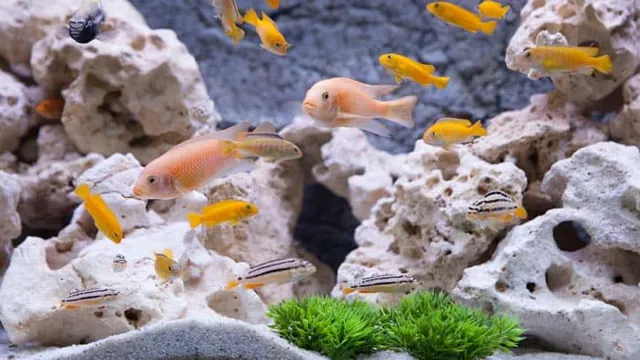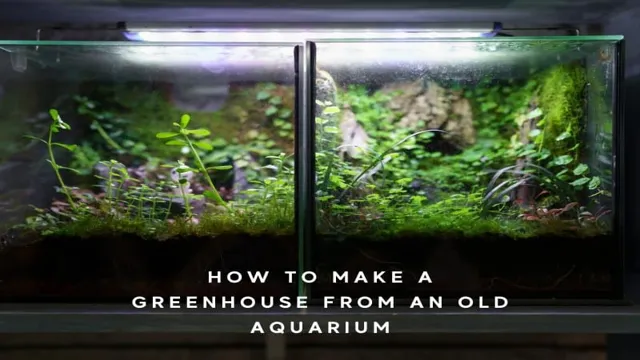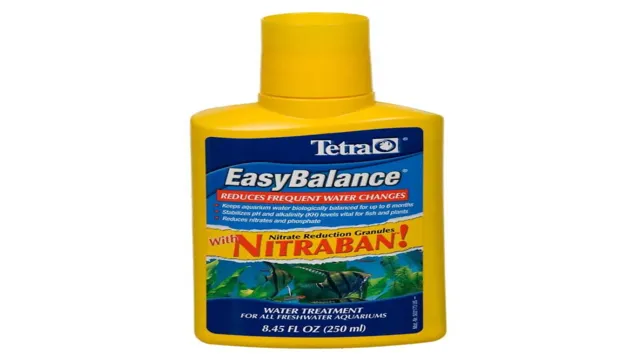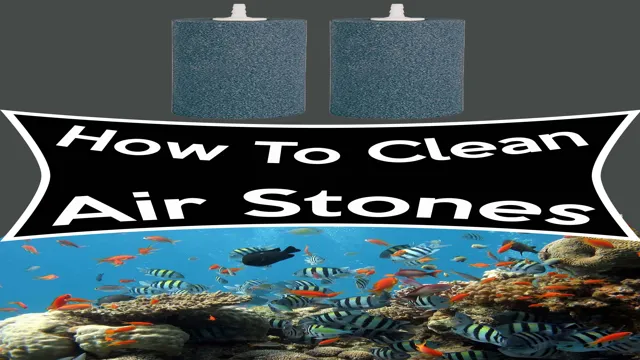How to Make a Mini Aquarium in a Jar: A Step-by-Step Guide for Beginners
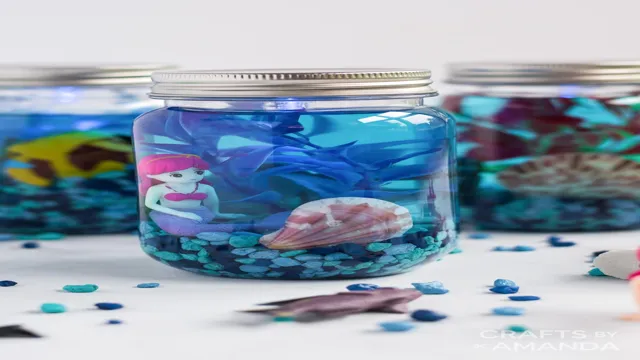
Looking for a creative and fun way to bring a little piece of the ocean into your home? Why not try making a mini aquarium in a jar? With just a few simple materials and some easy-to-follow steps, you can have your own little underwater world to admire whenever you want. Not only is it a great DIY project, but it’s also a unique way to decorate your home or office. Imagine having a tiny ecosystem right at your desk, brightening up your workday and reminding you of the beauty of nature.
So, let’s dive in and learn how to create your own mini aquarium in a jar!
Supplies Needed
If you’re looking for a fun and unique way to add a touch of aquatic life to your living space, why not try making a mini aquarium in a jar? To get started, you’ll need a few supplies including a clear glass jar or vase, aquatic plants or moss, aquarium gravel, a small aquatic figurine or ornament, and clean water. You may also want to consider purchasing a small filtration system or air pump to keep the water oxygenated and circulating. Once you have all of your supplies, begin by rinsing the gravel and placing it in the bottom of your jar.
Next, carefully add your plants and any ornaments, arranging them to your liking. Finally, fill the jar with clean water and turn on your filtration or air pump if you choose to use one. Voila! You now have a beautiful and unique mini aquarium to enjoy in your home.
Jar
If you’re planning on getting crafty and making your own jar, then you’ll need a few supplies to get started. First and foremost, you’ll need some clay to mold your jar. Make sure you choose a high-quality, air-drying clay that won’t crack or shrink as it dries.
You’ll also need some tools to shape the clay, such as a rolling pin, a knife, and a smoothing tool. A variety of paints and brushes will come in handy for decorating your jar after it’s dry. And if you want to add some extra flair, consider getting some ribbon, beads, or other embellishments to give your jar a unique touch.
With these supplies on hand, you’ll be well-equipped to create a beautiful and functional jar that’s all your own. So grab your clay and get started!
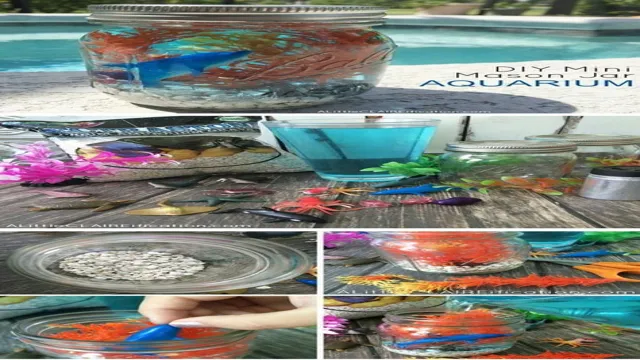
Pea Gravel or Sand
When deciding between pea gravel and sand, it is important to consider the supplies needed for each. Pea gravel requires less maintenance compared to sand, as it is less likely to wash away or erode over time. However, pea gravel does require a sturdy base layer, such as landscape fabric or a layer of crushed stone, to prevent it from sinking into the soil.
On the other hand, sand can be an easier option for a solid foundation, as it can simply be leveled and compacted. However, sand may require occasional replenishment and maintenance to prevent it from becoming uneven or developing washouts. Ultimately, the supplies needed for each type of material may vary depending on the specific project and site conditions.
It is important to consult with a professional to determine the best option for your needs.
Aquatic Plants
When it comes to setting up your aquatic plant aquarium, there are a few supplies that you will need to ensure the plants thrive and look their best. First and foremost, you will need a substrate that is suitable for aquatic plants. This can be anything from sand to gravel, but it should be specifically designed for use in aquariums.
You will also need a good quality fertilizer, as aquatic plants require a lot of nutrients to grow and flourish. Additionally, you will need a lighting system that supports plant growth. Look for a light that emits a spectrum of wavelengths that cater to the specific needs of aquatic plants.
Finally, you may want to consider adding CO2 injection to your setup. This gas helps the plants photosynthesize and can lead to a more vibrant and lush tank. By utilizing these supplies, you can create a beautiful and healthy aquatic plant aquarium that you can enjoy for years to come.
Small Decorative Items
If you’re looking to upgrade your home decor and add some small decorative items to spruce up your living spaces, there are a few things you will need to get started. First and foremost, investing in quality supplies is essential. Whether you’re creating your own DIY decorations or simply adding to your existing collection, having the right tools will make the process much easier and enjoyable.
Some essential supplies for small decorative items include hot glue guns, a variety of adhesives, scissors, paint, brushes, and embellishments such as ribbons, buttons, and beads. You can find these supplies at your local craft store or online, and it’s worth investing in good-quality materials to ensure that your decorations will last for years to come. By having the right collection of supplies at your disposal, you’ll be able to let your creativity run wild and create beautiful, unique, and personalized decorative items that speak to your personal style. (See Also: How to Get Green Algae off Aquarium Glass: Tips and Tricks for a Crystal Clear Tank)
So why not give it a try? With a little bit of effort, you’ll be amazed at how much joy and excitement you can bring to your living spaces with just a few small decorative items.
Water
When it comes to planning for a trip, one essential supply that should be on your checklist is water. No matter where you are headed to, it is crucial to stay hydrated during the travel. It is recommended to carry a refillable water bottle, which you can fill up anywhere to save money and reduce plastic waste.
You can also bring water purification tablets or a water filter if you are traveling to an area with limited access to clean drinking water. These supplies are relatively small and lightweight, making them easily portable. It is also essential to stock up on bottled water before setting out on a long journey, especially in hot and humid climates.
Remember that dehydration can cause fatigue, headaches, and even heat exhaustion. Adequate hydration ensures a comfortable and healthy trip. So, whether you are going on a short hike or a weeks-long camping trip, having a reliable source of water is a no-brainer.
Step-by-Step Instructions
Want to create a unique and mesmerizing mini aquarium in a jar? Follow these step-by-step instructions and impress your friends with your new aquatic creation! First, clean the jar thoroughly to avoid any contaminants. Decorate the bottom of the jar with small pebbles, sand, or colorful gemstones before filling it halfway with distilled water. Choose small aquatic plants, such as moss or java fern, and place them in the jar.
Add a small amount of aquarium gravel or sand to weigh them down and hold them in place. Next, add a few small, colorful fish or shrimp species compatible with your plant selection. Top the jar off with fresh distilled water, but don’t fill it all the way to the top to allow for air circulation.
Lastly, seal the lid and let the aquarium settle for a couple of hours before introducing it to light. Congratulations, you have now created your very own mini aquarium in a jar!
Step 1: Rinse the Jar and Gravel/Sand
When starting a new aquarium or terrarium, it’s important to properly prepare the container to ensure the health and safety of your new pets. The first step in this process is to rinse the jar and gravel or sand thoroughly. This will help remove any dust, dirt, or other contaminants that may have settled in during storage or transport.
To do this, simply fill the jar with water and swirl it around, then pour it out and repeat several times until the water runs clear. Likewise, rinse the gravel or sand separately under running water until the water no longer appears cloudy. By taking the time to complete this step, you’ll be well on your way to creating a comfortable and clean environment for your aquatic or reptilian friends.
Step 2: Add the Gravel/Sand to the Jar
Now that you have your clean jar and your rocks, it’s time to add in the next layer. It’s important to use a gravel or sand layer before adding in the soil to provide proper drainage and prevent standing water. Begin by adding a layer of gravel at the bottom of the jar, around 1-2 inches deep depending on the size of your jar.
You want to leave enough room for the soil and plant roots. Gently pat down the layer to make it even. Once you have added the gravel layer, you can add in a layer of sand on top.
Sand will provide additional drainage as well as a buffer zone for the roots of plants so they do not sit in standing water. Keep in mind that sand can make the jar heavier, so add only a thin layer. Now that the first two layers are complete, you can move on to adding in the soil layer.
Remember to choose a soil mix that is appropriate for the plants you plan to add to your jar. With the proper layers in place, you are ready to move on to the exciting part – choosing and planting your greenery!
Step 3: Add the Aquatic Plants and Decorative Items
As your aquarium water gets clearer, it’s time to add some aquatic plants and decorative items to enhance the overall look of your aquarium. But before adding them, you need to properly clean them and make sure they are suitable for the fishes in your aquarium. Use a sterile cloth to clean live plants and remove any unhealthy or dead parts.
Next, select your plants according to their compatibility with your fishes and water conditions. You can select from a variety of plants such as Anubias, Java Ferns, and hornworts that provide both shelter and oxygen to your fishes. You can also add decorative items such as rocks, driftwood, and aquarium sand to add some aesthetics to your aquarium. (See Also: How to Make Aquarium Sims 3: A Step-by-Step Guide to Creating Stunning Underwater Worlds)
Finally, make sure to place your plants and decorative items in suitable locations and provide adequate lighting for your plants. Adding aquatic plants and decorative items not only improves the look of your aquarium but also provides a healthy and comfortable environment for your precious pets.
Step 4: Fill the Jar with Water
Now that your terrarium is ready to go, it’s time to fill up the jar with water! This is a simple step, but it’s important to do it right in order to ensure the longevity of your plants. Begin by adding a layer of small pebbles or rocks to the bottom of the jar. This layer will provide drainage for any excess water and will keep the roots of your plants from getting waterlogged.
Next, fill the jar about one-third of the way with water. It’s essential not to overwater your terrarium, as this can lead to mold, bacterial growth, and plant rot. You want just enough water to keep the soil moist but not waterlogged.
Once the water is added, use a small spoon or chopstick to even out the soil and create small holes in which to plant your greenery. Don’t forget to mist the plants with water at least once a week to keep them healthy and hydrated. With a little bit of patience and care, you’ll soon have a thriving mini-garden right in your own home!
Maintenance Tips
If you’re looking for a fun and creative way to add a touch of the ocean to your room, why not consider making a mini aquarium in a jar? It’s not as difficult as you might think, and the results can be truly stunning! First of all, you’ll need to choose the right type of container. A clear glass jar works best, as it will allow you to see the aquatic plants and fish inside. Next, you’ll need to select some aquatic plants and add them to the jar along with some clean water.
Finally, you can add a few small fish, such as guppies or tetras. Remember, the key to maintaining your mini aquarium is keeping the water clean and well-circulated. So be sure to change a third of the water every week and add some new plants to help purify the water.
With a little bit of care and attention, you’ll have a beautiful mini aquarium in no time!
Keep the Water Clean
Keeping your pond water clean and clear is vital for maintaining the health and beauty of your aquatic environment. Regular maintenance is essential to ensure proper circulation, filtration, and sanitation. A few tips to keep in mind include checking and cleaning your filters regularly, removing any debris or fallen leaves that accumulate on the surface of the water, and balancing the pH levels.
It’s also crucial to properly stock your pond with the appropriate number of fish to avoid overloading the filtration system. Additionally, consider adding beneficial bacteria to your pond to promote healthy microbial activity and reduce the need for harsh chemicals. By staying on top of maintenance tasks and following these tips, you can enjoy a sparkling pond that’s a joy to behold.
Maintain the Plants
Maintaining plants may seem like a daunting task, especially if you’re not a seasoned gardener. However, with some basic maintenance tips, your greenery can thrive with minimal effort. One of the critical aspects of maintaining plants is watering them correctly.
Make sure you water them deeply, allowing the soil to absorb as much moisture as possible. Overwatering can be just as detrimental, as it can cause root rot, so be mindful of how much water your plants require. Additionally, it’s crucial to provide your plants with the right amount of sunshine.
Some plants need more light than others, so do some research on your specific plant. Lastly, pruning and trimming your plants can help promote healthy growth and prevent disease. Remove any dead or yellowing leaves, and pinch back any overgrowth.
These simple maintenance tips can ensure your plants remain healthy and vibrant, adding natural beauty to your home.
Clean the Jar Regularly
Cleaning the jar regularly is an essential part of maintaining its longevity and performance. With frequent use, bacteria and residue can accumulate in the corners and crevices of the jar, affecting the quality and taste of your food or drink. To prevent this, it’s recommended to clean the jar after every use by disassembling it and washing the individual parts with mild soap and warm water. (See Also: How to Maintain Aquarium Temperature without Heater: Tips and Tricks)
For tough or stubborn stains, a mixture of baking soda and water can be used to scrub off the residue. Additionally, it’s important to ensure that the jar is completely dry before reassembling it to prevent mold growth. Not only does regular cleaning improve the lifespan and effectiveness of your jar, but it also prevents potential health hazards from contaminated food or drink.
So, take the time to clean your jar after each use and enjoy clean and fresh results every time.
Conclusion
In conclusion, creating a mini aquarium in a jar is not only a fun and easy project, but it also adds a touch of nature to any space. By following these simple steps and being creative with your decorations and fish selections, you can turn any ordinary jar into a captivating aquatic paradise. So go ahead, dive into this DIY project and let your creativity swim wild.
Just remember, as with any aquarium, it’s important to maintain the environment for your fish to thrive and keep the water clean. Happy building!”
FAQs
What materials do I need to make a mini aquarium in a jar?
You will need a glass jar, aquarium gravel, small plants, small decorative items, and fish food (if you plan on adding fish).
Can I put live fish in a mini aquarium jar?
Yes, but you must ensure that the jar is big enough for the fish, has proper filtration, and regular water changes. It is recommended to only keep one small fish in a mini aquarium jar.
How often should I change the water in my mini aquarium jar?
You should change the water in your mini aquarium jar every 1-2 weeks, depending on the size of the jar and the number of fish.
Can I use tap water for my mini aquarium jar?
Yes, but be sure to treat the water with a dechlorinator before adding any fish or live plants.
What types of plants are suitable for a mini aquarium jar?
Small plants that do not require a lot of space, such as java fern, anubias, or moss, are suitable for a mini aquarium jar.
How much light does my mini aquarium jar need?
Your mini aquarium jar will require a few hours of indirect sunlight or a low wattage LED light to support plant growth.
How do I maintain the cleanliness of my mini aquarium jar?
Regularly remove any uneaten food, debris, or dead plant matter. It is also important to regularly change the water, and clean the glass with a soft sponge or cloth.


